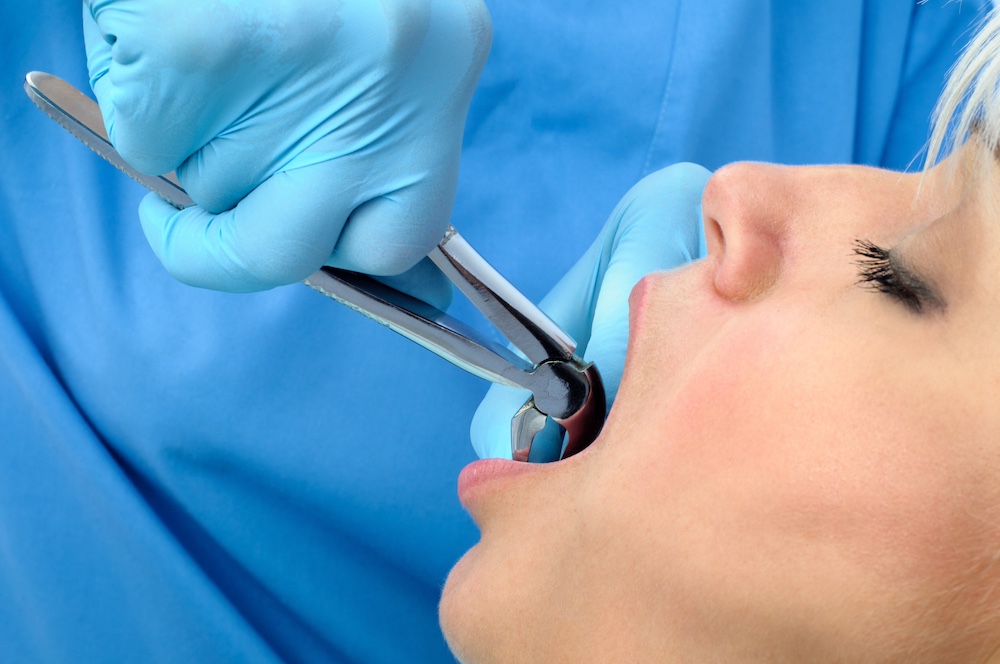While being told you need a tooth extraction is the last thing you want to hear from your dentist, it’s sometimes the necessary solution to prevent further issues from tooth damage or decay. It’s among the most common dental procedures used to improve oral health and involves completely removing a tooth from its socket. Dentists, periodontists, and oral surgeons all perform tooth extractions, with more complex cases such as impacted teeth often being referred to oral surgeons.
There are several benefits to tooth extraction, the biggest being the elimination of harmful bacteria that can spread and damage additional teeth and gums. This leads to more oral health issues that could have been avoided with a simple extraction. In addition, tooth extraction can alleviate chronic dental pain from a damaged or decayed tooth.
When is tooth extraction recommended?
A dentist’s priority is always to save a natural tooth, but when other restorative measures like fillings and crowns aren’t successful, extraction is often the next step. Tooth extraction is reserved as a last resort for teeth that are damaged or decayed beyond repair and helps improve oral health.
Tooth extraction is recommended in the following scenarios:
- Advanced gum disease
- Severe tooth decay from cavities
- Fractured tooth
- Impacted tooth
- Crowded teeth
While the overwhelming majority of tooth extractions are from decay and damage, tooth extraction is also commonplace for adolescents going through the process of getting braces. It’s common to need a tooth or multiple teeth removed before braces in cases of overcrowding or impacted adult teeth. Regardless of the reason, the need for extraction is confirmed through an examination and dental X-rays, and a separate appointment will be set for the procedure.
What happens during the extraction process?
Your dentist will discuss the extraction process with you in detail—from sedation to replacement options for the gap left behind. You will be offered varying levels of sedation for your procedure, with your dentist providing a recommendation based on your level of anxiety and the extent of work needed for the extraction.
Dental sedation options include:
- Nitrous oxide – Known as “laughing gas,” nitrous oxide is inhaled through a mask or nose piece with calming effects felt within 3-5 minutes. While you are fully awake during the procedure, you feel calm and relaxed and feel no pain thanks to the dentist also using local anesthesia to numb the area around the affected tooth.
- Oral conscious sedation – This pill-form sedative is taken an hour before your extraction and induces light sleep. However, it’s a light slumber that allows you to maintain communication with your dentist.
- Intravenous (IV) sedation – The deepest form of dental sedation, this sedative is delivered directly to the bloodstream through an IV and requires careful monitoring of vitals throughout the procedure. IV sedation will make you fall asleep with no memory of the procedure after awakening.
Once the procedure is underway, the dentist will use specialized dental instruments to slowly and gently loosen the tooth—eventually pulling it away from the socket along with the root. An incision is sometimes needed along the gum line to help the process, which is often the case for teeth that are broken at the gum line. After successfully removing the tooth, the socket is cleaned and disinfected to avoid infection. Stitches are the final step in the process to secure the gap and encourage healing.
What should I expect following tooth extraction?
Your dentist will leave you with plenty of gauze following the extraction, with instructions to bite down on it with firm pressure to help slow any bleeding. Clotting is the immediate goal, reducing the risk of dry socket.
Light bleeding is expected and normal for the 24 hours that follow a tooth extraction. Post-procedure instructions from your dentist or oral surgeon will likely include avoiding solid foods as well as straws, which can dislodge clots from the tooth socket and lead to dry socket.
Aftercare instructions will also include keeping the extraction site clean by gently rinsing with an antimicrobial mouthwash a few times a day, avoiding brushing directly over the extraction site, and taking any pain relievers or antibiotics prescribed. Over-the-counter pain medications are also acceptable to use post-procedure.
What is dry socket, and why is it a concern after a tooth extraction?
According to the American Dental Association, dry socket is a painful condition resulting from the blood clot becoming dislodged from a tooth extraction site, exposing the underlying bone and nerves. A blood clot forms at the site of the tooth removal, serving as a protective layer over the underlying bone and nerve endings. In addition, these clots contain vital cells that are important for proper healing.
When that blood clot is dislodged early in the healing process, intense pain occurs in the socket, as well as the nerves felt in the mouth and face. The socket can become swollen and irritated and may even begin to fill with food. Most cases of dry socket happen 1 to 3 days after tooth extraction, and it is the most common complication following tooth removal. Over-the-counter pain medications are not typically enough to treat dry socket pain, so contact your dentist or oral surgeon for more effective pain relief options.
How long after tooth extraction can I resume normal activities?
While total recovery is dependent on each particular situation and the number of teeth extracted, most people can return to normal daily activities within 24 hours and rigorous activity after 48 hours. A normal diet can be resumed within 72 hours—although acidic, sticky, and crunchy foods should be avoided for approximately two weeks to avoid dislodging the blood clot within the tooth socket. If receiving a dental implant is part of your tooth extraction process to fill the gap left behind, a couple of months is set aside for complete healing before the post and crown can be completed.
Are there any potential complications with tooth extraction?
No medical procedure is without risk of complications, however minor. Tooth extraction comes with a very small risk of issues, which should be addressed with your dentist or oral surgeon to alleviate any concerns.
Possible complications arising from tooth extraction include:
- Infection
- Dry socket
- Nerve damage
- Sinus perforation
- Delayed healing
The American Dental Association provides additional insight on tooth extractions, including tips on making the recovery process easier. Contact us if you have any questions or concerns about tooth extraction, including when it's necessary, the procedure itself, and aftercare.


